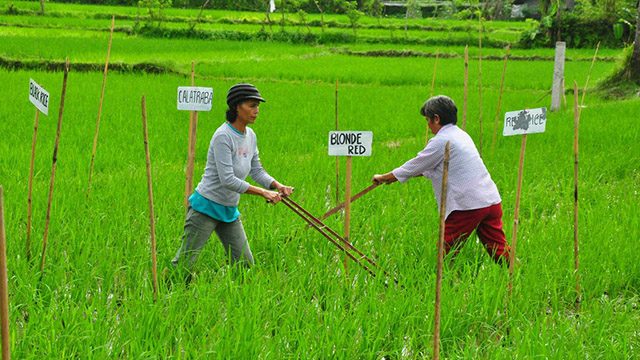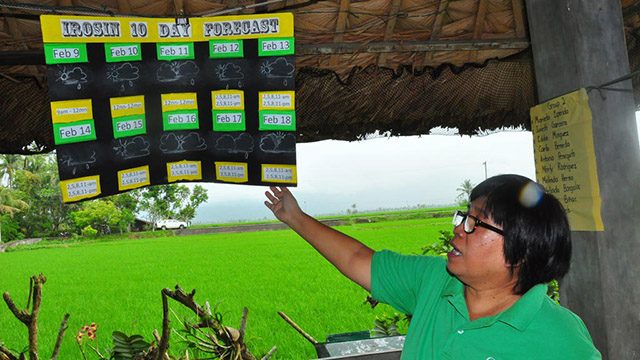SUMMARY
This is AI generated summarization, which may have errors. For context, always refer to the full article.

MANILA, Philippines – Irosin is considered the rice granary in Sorsogon yet it is also the most vulnerable to natural disasters and calamities.
The only landlocked municipality in the province, the town is situated in a caldera (formed when a summit of a volcano collapses into its empty magma chamber) of the Bulusan Volcanic Complex. What used to be an undisturbed valley became an area known for its farming villages.
However, the unrelenting threats of disasters continue to challenge the residents.
According to municipal agriculturist Nimfa Ferolino, 80% of the population of Irosin depend on agriculture as the main source of income. With typhoons and the changing climate, rice production and the lives of families are affected.
“Kapag naapektuhan kami ng masamang panahon talaga, maapektuhan din yung daloy ng bigas sa probinsya at marami ang magugutom,” she told Rappler. “Pero mas malaki ang nagiging problema ng mga tao na nagsasaka kasi nawawalan sila ng pera.”
(When we’re affected by bad weather, rice supply of the province is also affected and many go hungry. But the big burden is on farmers because they lose money.)
A World Food Programme report said that lack of efforts to help communities become climate resilient may increase the current number of people suffering from hunger by 20%. It can also result in a 500-calorie decrease in consumption. (READ: What climate change means to the world’s hungry people)
Becoming resilient
In 2011, Rice Watch and Action Network (R1) and the Department of Science and Technology (DOST) started the Climate Resiliency Field School (CRFS) in Irosin to address these problems. WFP joined the project in 2013.
CRFS aims to educate farming communities about the changing climate and the many ways they can adapt to better suit their livelihood. It was also designed to provide local government units with early warning advisories and identify possible risks.
The 2nd class municipality in Sorsogon was one of the two flagship areas, the other one being Tarlac.
However, beyond the warning systems, Ferolino said that the biggest contribution of CRFS to farmers is the hands-on training they get toward resilient farming.

“Ang dala ng proyekto ay naihanda ang mga farmers at naging resilient sila sa pabago- bagong panahon,” she emphasized. “Nadagdagan ang kanilang kaalaman dahil sa trainings laban sa climate change at epekto nito sa kanilang pamumuhay.”
(What the project brings is that farmers are now ready and resilient against changing climate. They are now equipped with the right skills and information through training against climate change and its effects on their livelihood.)
Each year, there are two tranches of training with 2-3 groups. Up to 40 farmers in each group go through 16 weeks, covering all stages of rice farming which include land preparation for harvesting.
Within the period, the farmers test the kind of rice variant best suited to their environment. According to Ferolino, this is where the importance of the early warning system is highlighted.
To date, more than a hundred farmers, not just from Irosin, but from nearby Sorsogon towns have benefited from the CRFS.
Addressing poverty, above all
Farmers are the top food producers. As an agricultural country, rice has become a staple among Filipino households.
While producing very in-demand products, farmers are still the poorest in the Philippines. According to the Philippine Statistics Authority, poverty incidence in this sector has remained unchanged since 2008.
This is feared to continue due to threats of extreme weather events affecting the country. A United Nations report said that agricultural resources will bear climate change’s “most devastating impact” leading to more problems of poverty and food insecurity. (READ: Food security amid a changing climate)

What sets CRFS apart from other projects is that it is not all about planting and harvesting – it also aims to address the unchanging patterns of poverty among farmers through other means.
The additional skills they get augment their income from farming.
“Maganda talaga ito kasi nabibigyan sila ng ibang option para sa income,” Ferolino said. “Para kapag nagkataon na nasira ang kanilang mga pananim bigla dahil sa bagyo o kalamidad, may magagastos silang pera at hindi na kailangang mangutang at malugmok ulit sa kahirapan.”
(This is really good because they are given other options for income. So in the event that what they planted is destroyed by typhoons or a calamity, they have money to spend and they don’t need to borrow money and be submerged again in poverty.)
Enrolled farmers and their families also undergo several livelihood trainings to give them other sources of income to help them address the poverty situation in their area. These include herbal soap making, organic fertilizers production, bio fertilizer spray, and mushroom production.
According to a study done by the Food and Agricultural Organization, improving the situation of the agricultural sector can end poverty as a whole and help the economy.
This kind of grassroots initiative highlights the importance of piercing together skills and information against hunger and poverty – especially among rural communities.
“Hindi lang talaga impormasyon ang nabibigay nito sa mga farmers,” Ferolino said. “Maliban sa kaalaman, iyong options din para maging maayos ang kanilang buhay ay naibibigay.”
(It is not only information that is given to farmers. Aside from information, they are also given other options to improve their lives.) – Rappler.com
October 16 is the World Food Day! How can we address hunger in the Philippines? Tweet using the hashtag #HungerProject!
Add a comment
How does this make you feel?
There are no comments yet. Add your comment to start the conversation.